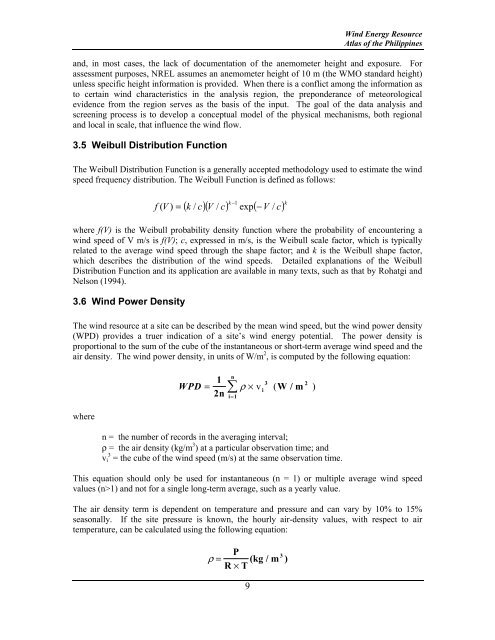Wind Energy Resource Atlas of the Philippines - NREL
Wind Energy Resource Atlas of the Philippines - NREL
Wind Energy Resource Atlas of the Philippines - NREL
You also want an ePaper? Increase the reach of your titles
YUMPU automatically turns print PDFs into web optimized ePapers that Google loves.
9<br />
<strong>Wind</strong> <strong>Energy</strong> <strong>Resource</strong><br />
<strong>Atlas</strong> <strong>of</strong> <strong>the</strong> <strong>Philippines</strong><br />
and, in most cases, <strong>the</strong> lack <strong>of</strong> documentation <strong>of</strong> <strong>the</strong> anemometer height and exposure. For<br />
assessment purposes, <strong>NREL</strong> assumes an anemometer height <strong>of</strong> 10 m (<strong>the</strong> WMO standard height)<br />
unless specific height information is provided. When <strong>the</strong>re is a conflict among <strong>the</strong> information as<br />
to certain wind characteristics in <strong>the</strong> analysis region, <strong>the</strong> preponderance <strong>of</strong> meteorological<br />
evidence from <strong>the</strong> region serves as <strong>the</strong> basis <strong>of</strong> <strong>the</strong> input. The goal <strong>of</strong> <strong>the</strong> data analysis and<br />
screening process is to develop a conceptual model <strong>of</strong> <strong>the</strong> physical mechanisms, both regional<br />
and local in scale, that influence <strong>the</strong> wind flow.<br />
3.5 Weibull Distribution Function<br />
The Weibull Distribution Function is a generally accepted methodology used to estimate <strong>the</strong> wind<br />
speed frequency distribution. The Weibull Function is defined as follows:<br />
where f(V) is <strong>the</strong> Weibull probability density function where <strong>the</strong> probability <strong>of</strong> encountering a<br />
wind speed <strong>of</strong> V m/s is f(V); c, expressed in m/s, is <strong>the</strong> Weibull scale factor, which is typically<br />
related to <strong>the</strong> average wind speed through <strong>the</strong> shape factor; and k is <strong>the</strong> Weibull shape factor,<br />
which describes <strong>the</strong> distribution <strong>of</strong> <strong>the</strong> wind speeds. Detailed explanations <strong>of</strong> <strong>the</strong> Weibull<br />
Distribution Function and its application are available in many texts, such as that by Rohatgi and<br />
Nelson (1994).<br />
3.6 <strong>Wind</strong> Power Density<br />
The wind resource at a site can be described by <strong>the</strong> mean wind speed, but <strong>the</strong> wind power density<br />
(WPD) provides a truer indication <strong>of</strong> a site’s wind energy potential. The power density is<br />
proportional to <strong>the</strong> sum <strong>of</strong> <strong>the</strong> cube <strong>of</strong> <strong>the</strong> instantaneous or short-term average wind speed and <strong>the</strong><br />
air density. The wind power density, in units <strong>of</strong> W/m 2 , is computed by <strong>the</strong> following equation:<br />
where<br />
( )( ) ( ) k<br />
k −1<br />
k / c V / c exp −V<br />
c<br />
f ( V ) =<br />
/<br />
n<br />
1<br />
3 2<br />
WPD = ∑ ρ × v i ( W/m )<br />
2n<br />
n = <strong>the</strong> number <strong>of</strong> records in <strong>the</strong> averaging interval;<br />
ρ = <strong>the</strong> air density (kg/m 3 ) at a particular observation time; and<br />
vi 3 = <strong>the</strong> cube <strong>of</strong> <strong>the</strong> wind speed (m/s) at <strong>the</strong> same observation time.<br />
i= 1<br />
This equation should only be used for instantaneous (n = 1) or multiple average wind speed<br />
values (n>1) and not for a single long-term average, such as a yearly value.<br />
The air density term is dependent on temperature and pressure and can vary by 10% to 15%<br />
seasonally. If <strong>the</strong> site pressure is known, <strong>the</strong> hourly air-density values, with respect to air<br />
temperature, can be calculated using <strong>the</strong> following equation:<br />
ρ =<br />
P<br />
3<br />
(kg / m )<br />
R× T
















